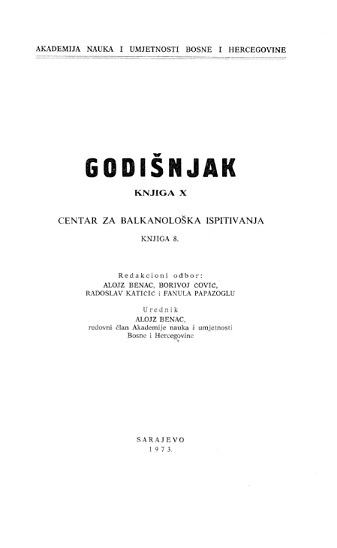Govori jugoslovenskih Cigana u okviru balkanskog jezičkog saveza
The Dialects of Yugoslav Gypsies within the Balkan Language Union
Author(s): Rade UhlikSubject(s): Ethnohistory, Syntax, Lexis, Historical Linguistics, Sociolinguistics, Philology
Published by: Akademija Nauka i Umjetnosti Bosne i Hercegovine
Keywords: Balkan languages; Yugoslavia; Balkan language union; Gypsies; Gipsy dialect;
Summary/Abstract: The languages of the Balkan Peninsula have for a long time had a number of structural features in common. However, these features, found in their phonetics, morphology, and syntax, arc not always manifested to the same extent, nor are they always present in the same way. Still, the Balkan languages are clearly different from the languages spoken outside this area, which suggests either a foreign influence, or a common linguistic heritage. While the vocabulary of ancient Balkan languages is almost completely lost, some strange and original spirit still emanates from the Balkan sentence. It is not at all my intention to offer a solution to the problem of the genesis of the Paleo-Balkan language substratum, whose existence is strongly felt by anyone dealing with a Balkan language. My own starting point is that there must have existed a Balkan language community, founded on some basis which was more or less common. Consequently, my chief purpose here is to point to some features in the dialects of Yugoslav Gipsies which can serve as indisputable evidence of the influence of a compact Balkan community. These features, thus, establish the Gipsy language as part of the Balkan sprachbund, which, egain, connects more or less to the Paleo-Balkan language substratum. Various barbarian peoples from the north invaded the Balkans during the Grand Exodus at the beginning and around the middle of the first millenium A.D. The language of the invaders started spreading among the old inhabitants of the Balkans, who had by that time been largely romanized. Only a few traces were preserved' of the original language of the old inhabitants, but they represent a precious heritage. The Paleo-Balkan substratum has given a uniform impact to the present day heterogenous population of the Balkan peninsula. Apparently the remnants of the old substratum had not completely disappeared. They must have remained latent for a while and then reappeared after several centuries. This is, indeed, a unique case of that kind of phenomena. That substratum showed a strange vitality by penetrating as an adstratum mediated by modern Balkan languages, into the languages of the most recent settlers of the Balkan peninsula, who had come here around the end of the Middle Ages. These were Gipsies and Sephardic (Spanish) Jews, who adopted features of the old substratum within a comparatively brief period of time. The Paleo-Balkan substratum is manifested chiefly by the following five features (1) Anticipation. This often eliminates possible ambiguity from the Gipsy sentence and thus contributes to its clarity. (2) Post-postitioned article. One ot the functions of this article is to make the indefinite form of the adjective, which would otherwise be non-existent in Gipsy. While pre-postioned article is found in numerous languages all over the world, the post-positioned article is almost a unique Balkan category. In the dialects of the Walladk Gipsies, this article still survives, although only as a dead affix with no function and hardly any meaning, while in the Turkish and Greek Gipsy dialects there is no trace of it. (3) Ethical dative. This dative conjures up intimacy and closeness of certain situations and thus saves the use of other elements. This dative is characteristic of the Balkan languages. (4) Regression of the infinitive and its replacement. Finite forms of the subjunctive mode replace their non-finite counterpart the infinitive mode. (5) Analytic formation of the Simple Future tense and the Present Conditional. This is done by means of the verb kamam (wil, want). The analytic forms are definitely prevalent, although parallel use of both analytic and synthetic forms is found in some dialects. Of the above phenomena (1) and (2) affect the noun phrase, while (3), (4) and (5) are manifested, in the domain of the verb phrase. Other less important manifestations of the old language substratum will not be discussed here. A Yugoslav will encounter some difficulty in understanding the »Balkan sentence«, especially because of anticipation and the lack of synthetic case forms. Fortunately anticipation is limited to only a small number of Gipsy dialects, and the Gipsy language has an abundance of cases, namely eight. It is interesting to note that Turkish-Greek Gipsies, who are nearly all Moslim, that is of the same faith as the one-time ruling Osmanlies, did not admit into their language the ’infidel’ post-positioned article. It appears that the old substratum was at places looked down on as a mark of the occupied Christian masses. The post-positioned article did not enter the languages of the Islamic peoples of Y-uruks, Yoga is Circassians, and others, vho had been colonized by the Osmanlies all, over the Balkan Peninsula to serve as pillars of their domination. Nevertheless, Albanians do not belong to this group, although they are about two thirds Moslim. They are, however, old inhabitants of the Balkans, and were not colonized by the Turks and were thus not very dependent on them. This pan-Balkan linguistic phenomenon is indeed a rarity of its kind: eight small, more or less heterogeneous peoples who live on a relatively limited area speak languages whose structures are characterized by a number of common features. Let us now look at these languages individually.
Journal: Godišnjak Centra za balkanološka ispitivanja
- Issue Year: 1973
- Issue No: 10
- Page Range: 53-108
- Page Count: 56
- Language: Bosnian

